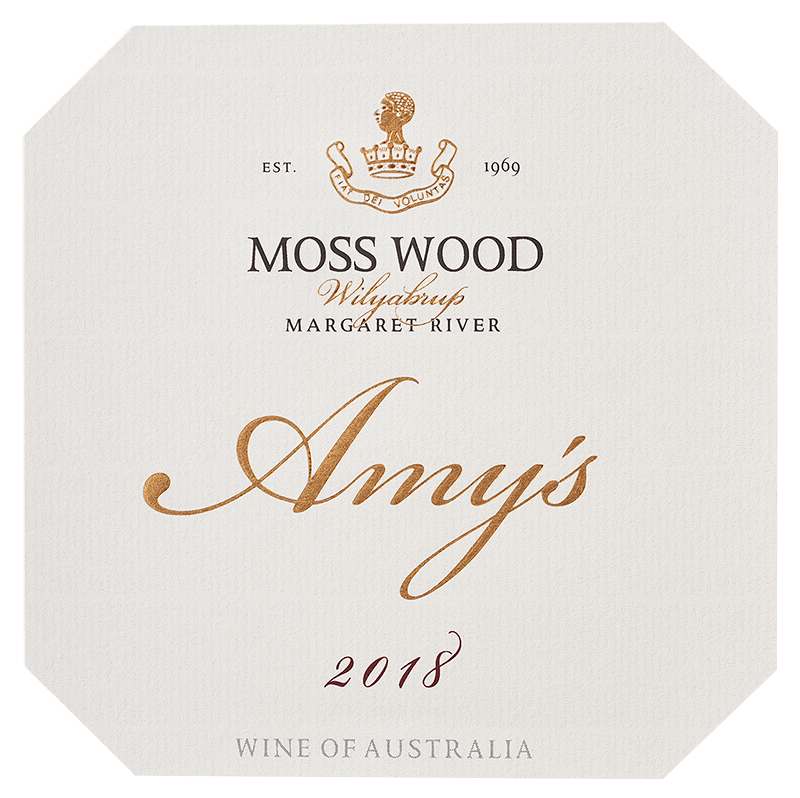Moss Wood 2018 Amy’s

Wine Facts
Harvested
Glenmore Cabernet Sauvignon – 28th March, 2018
Glenmore Merlot – 13th March, 2018
Glenmore Malbec – 13th April, 2018
Glenmore Petit Verdot – 28th March, 2018
Bottled - 06/11/2019
Released - 01/03/2020
Beaume
Glenmore Cabernet Sauvignon – 14.5° Baume
Glenmore Merlot – 14.6° Baume
Glenmore Malbec – 14.5° Baume
Glenmore Petit Verdot – 13.8° Baume
Alcohol - 14.0%
Moss Wood 2023 Amy’s – Erin Larkin, The Wine Advocate
The 2023 Amy’s hails from a superb vintage in Margaret River. Mild, dry conditions set the tone for the season, and while many of the wines are yet to be released, the early indications are that this could be one of the most astounding vintages of Margaret River’s modern era…
Tasting Notes
Colour and condition: Deep, brick red hue, almost blue notes; bright condition.
Nose: There is good volume and lift, with an array of aromas expected from this blend, with all varieties making their presence felt. Cabernet Sauvignon dominates, so its blueberries and violets are clear, while Petit Verdot brings its dark berry and jubes, Merlot supporting with black currant and Malbec providing red fruit, almost watermelon-like and some white pepper spice. The complex notes typical of a Cabernet blend fill out the background with cedar and tobacco and despite being aged in exclusively old barrels some soft oak as well.
Palate: As expected from the nose, the red and dark fruits dominate and fill the mouth, giving the wine tremendous length. They sit over a firm but balanced structure, with acidity that is lifted, ensuring the fruit flavours are lively, full body gives good density and mouthfeel and on the finish, the tannins provide an astringency that doesn’t disrupt, being smooth with no furry or bitter edges.
Cellaring: The Moss Wood Amy’s is produced in a style specifically intended to have early appeal. The generous fruit characters and well-balanced tannin structure ensure it can be enjoyed as a youngster. Of course, Margaret River Cabernet Sauvignon has a tremendous reputation for cellaring and the 2018 Amy’s will certainly short term cellaring of say 5 years but we encourage customers to appreciate and enjoy its attractive fruit flavours now and save space in their cellar for our Ribbon Vale or Moss Wood Cabernet Sauvignons.
Vintage Notes
The 2017 calendar year delivered a very healthy rainfall of 1117mm, 10% above average. This, combined with the pristine spring weather, meant that the vines were primed for an almost perfect growing season. We were fortunate to avoid any significant inclement weather during flowering and rarely experienced temperatures below 8C. All of the above factors meant that we were confident heading into the Summer ripening period.
The Summer of 2018 was characterised by moderate temperatures which were conducive to slow, even ripening. Full sugar and flavour ripeness was achieved in all varieties, and this occurred about one week later than average.
The Merlot was the first fruit to come off the Glenmore Vineyard in mid-March, closely followed by the Cabernet Sauvignon and Malbec in late- March. The Petit Verdot was the last fruit picked in mid-April. All fruit was received in the winery in excellent condition, free from disease and bird damage.
PRODUCTION NOTES
Once delivered to the winery, the fruit was hand-sorted to remove any matter other than grape (i.e. leaves, stick, etc) that may have been brought in from the vineyard, and must pumped into closed fermenters. In tank, the must was inoculated for primary fermentation and pumpovers were conducted 3 times daily to enhance flavour and colour extraction. Once each fermentation had gone past 0° Baume, daily tastings were conducted to determine whether tannin balance had been achieved. When we were comfortable that the wine was not benefiting from further time on skins we pressed. In 2018 the time on skins varied, with the Cabernet Sauvignon having 13 days, the Merlot 10 days, the Malbec 10 days and the Petit Verdot 11 days.
After pressing, Malolactic Fermentation was completed in tank and all batches were racked to 228 litre French oak barrels, with no new oak used. The wine remained in barrel for 18 months – long enough to gather sufficient oak complexity whilst still retaining the vibrant fruit aromas and flavours we desire in this blend. Each batch was then racked out of barrel and blended in stainless steel tank. We then conducted fining trials and determined that the wine had excellent balance and didn’t benefit from any of the fining agents, so the wine remained untreated. It was then sterile filtered and bottled on 6th November, 2019.
The final blend is Cabernet Sauvignon 76%, Merlot 8%, Malbec 8%, Petit Verdot 8%.

